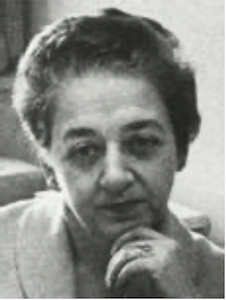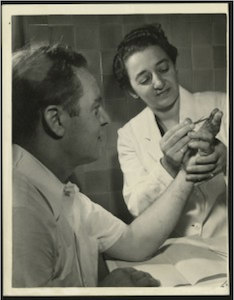
Alma Dea Morani was born on March 21, 1907, in New York City, New York, to Salvatore and Amalia Gracci, who both immigrated to America from Italy. Morani’s father, Salvatore, was a sculptor and painter, while her mother, Amalia, was a language tutor. Morani was raised exceptionally skillful in art through her father, who diligently strived to invest in her future as an artist, as he believed in the comforting power that art has on others. Her father passed down his love for art to Morani, making art a lifelong passion of hers. Although she would not end up becoming an artist, Morani used the artistic talent to help restore her patients through plastic surgery.
Morani’s interest in the medical field sparked as a fifteen-year-old girl scout when she participated in a first aid course, learning how to treat and repair different injuries. This training inspired Morani to become what she first referred to as a "repair doctor." Soon after completing high school, Morani attended New York University for her undergraduate education, graduating in 1928. She then received her M.D. at the Woman’s Medical College of Pennsylvania in 1931. Morani began her pursuits in surgery and started to explore new grounds as a female in the field. Notably, she began an internship at St. James Hospital in Newark, New Jersey, becoming the first female surgical intern at the hospital. After one year of interning in New Jersey, she returned to the Woman’s Medical College of Pennsylvania and became the first female surgical resident until 1935. For three years afterward, she worked as an assistant surgeon for general surgery.
However, Morani began to grow tired of the path that general surgery required for admission into the American College of Surgeons. As a result, from 1938 to 1941, Morani took plastic surgery more seriously, as she found that it exercised her artistic background. In 1941, she was admitted to the American College of Surgeons with a focus on plastics.

Finding courses to practice plastic surgery under was challenging for Morani, as there were not many that accepted women. After searching for six years, Dr. Morani finally got the opportunity to study with esteemed plastic surgeon, “Colonel” James Barret Brown, in St. Louis, Missouri. There, Morani learned about advanced plastic surgical techniques, which deepened her knowledge of the speciality substantially. Unfortunately, Dr. Brown did not allow her to exercise her abilities, as she was only allowed to observe the procedures being done but never got to perform any because she was a woman.
Despite the obstacles, Morani made the best out of these limitations and utilized her talent as an artist, making sketches and photographing surgical operations. Dr. Morani’s determination through her craft eventually caught Dr. Brown’s attention, and he allowed her to assist him in surgery. Still, these new opportunities were not without limits. Dr. Brown insisted that Morani could only perform procedures on “Saturdays when everybody else went to play golf." Although her internship in St. Louis was not ideal, she still won the applause of her well respected mentor, who had acclaimed her for the intelligence and perseverance she displayed throughout her time working with him. Soon after, Dr. Morani became the first woman admitted to the American Society of Plastic and Reconstructive Surgeons in 1947.

Dr. Alma Morani returned to her Alma Mater in 1948 where she served as a professor until 1975. Concurrently, she continued to spread her expertise and help people worldwide through her advancements in surgical-enhancement. Dr. Morani expanded her service by establishing Philadelphia's first Hand Surgery Clinic, volunteering at Valley Forge Hospital to perform surgery on wounded WWII soldiers, and traveling the world raising money for women's clinics in Taiwan, the Balkans, Russia, and the Philippines.
Although she did not become an artist, Dr. Morani deeply valued her artistic skills and incorporated them into her work. When she retired from her surgical career in 1972 at the age of 65, Dr. Morani began studying the role of art in medicine. She stood firm in her belief that an appreciation of art would enhance the skills of any medical doctor, so she wrote articles and held lectures to spread this insight. To emphasize and celebrate the correlation between art and medicine, Morani established the Morani Gallery of Art in 1985 at Woman's Medical College, where she donated over 250 works crafted by her and her father.
Morani passed away on January 27th, 2001, shortly before the Alma Dea Morani Award was created. The award recognizes female pioneers in medicine and science who have showcased their professional brilliance, longing for enlightenment, and the fulfillment of service beyond their medical practice, akin to the message that Dr. Alma Dea Morani’s life beholds. Dr. Morani’s dream and her efforts to achieve it have allowed her to be the face of many “firsts” for women in the surgical field, inspiring others to break boundaries and reach success.
Why Did I Choose to Research Alma Dea Morani?
As someone who has always been amazed by the power of surgery, I became invested in Dr. Morani’s story the instant I began researching her. Morani’s persistence and bravery throughout her career inspired me and I believe that it would do the same for others, especially those who feel that they cannot pursue their dreams due to restrictions and limitations placed upon them. In addition, Morani utilized her talents and interests of art and medicine in her humanitarian efforts to aid and comfort others. By writing about Dr. Morani, I wish to spread the message that her life exhibits: By breaking boundaries and making the most out of your situation, you can pursue your passions and talents, all while bettering the lives around you.
Works Cited
Alma Dea Morani. Omeka RSS. (n.d.). Retrieved June 18, 2022, from https://collections.countway.harvard.edu/onview/exhibits/show/fhwim-oral-histories/renaissance-women-in-medicine-/award-winners/alma-dea-morani
Foundation, W. in M. L. (2018, June 26) Pioneers in microbiology win alma Dea Morani M.D. renaissance woman award. Pioneers in Microbiology Win Alma Dea Morani M.D. Renaissance Woman Award. Retrieved June 18, 2022, from https://www.prnewswire.com/news-releases/pioneers-in-microbiology-win-alma-dea-morani-md-renaissance-woman-award-300485440.html
From the Division of Plastic Surgery. (n.d.). Alma Dea Morani, MD: A Pioneer in plastic surgery : Annals of plastic surgery. LWW. Retrieved June 18, 2022, from https://journals.lww.com/annalsplasticsurgery/Abstract/1997/04000/Alma_Dea_Morani,_MD__A_Pioneer_in_Plastic_Surgery.21.aspx
National Institutes of Health. (2015, June 3). Changing the face of Medicine | Alma Dea Morani. U.S. National Library of Medicine. Retrieved June 18, 2022, from https://cfmedicine.nlm.nih.gov/physicians/biography_229.html
This article was published on 3/1/24